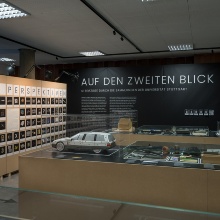Exhibition
Where: Foyer of the University Library Stadtmitte (city center), 16 Holzgartenstr. When: Until May 28, 2022, daily from 10 a.m. to 6 p.m.
Free admission
Guided tours and talks on May 12 and May 18
The exhibits presented are part of the university’s total of 19 collections, and are in part on public display for the first time. Visitors can see antique coins, collectibles from the biology and natural history departments, mathematical models and instruments, historical measuring devices from communications engineering, historical prints, playback equipment for media, building material samples, architectural models, drawings as well as objects from the collections of the Automotive Engineering, Mechanical Handling and Logistics, Navigation, and Space Systems institutes.
Exploring the university’s inventories
The students who organized the exhibition deliberately grouped the exhibits not according to individual collections, but according to five thematic fields that outline important contexts for collecting items at the University of Stuttgart. Objects framed in magenta catch the eye as thematic focal points. The parts of a laser scanner from the collection of the Institute of Navigation are reminiscent of the fact that this device was demonstrated to Mikhail Gorbachev when he was visiting the university in 1989. Mechanical gyroscopes as independent navigation aids in aerospace technology showcase new utilization concepts for a former teaching and research collection up to an interdisciplinary research project that has a pioneering role in 3D digitization. Worn ropes give insight into the work of the Institute of Mechanical Handling and Logistics. The Barbecube shows how the collaboration with industry can lead to creative student research projects. The small grill from the model library of the Institute for Engineering Design and Industrial Design and the Institute of Machine Components is the result of a Bachelor’s thesis. The company Trumpf even produced it in small quantities for some time. A true-to-detail student model of the Pantheon in Rome from the collection of the Faculty of Architecture and Urban Planning demonstrates how budding architects use model making to rediscover and reinterpret even the great masterpieces of architectural history.
Guided tours for groups are also available. Please contact Beate Ceranski and Else Schlegel.
Talks, videos, and more
More details can be discovered via the objects’ QR codes. The program accompanying the exhibition invites to talks and gives visitors the opportunity to meet experts on the respective collections, who can also be seen and listened to in a video installation. There, you can learn more about the respective collections and the individual objects, some of which - both then and now - help students to get a grasp of something, in the truest sense of the word.
A large blackboard, the so-called “grid”, is being used as a background behind the exhibition tables and expands the context of the exhibits on display. About 300 index cards, each presenting yet another object from the university’s collections, are pinned to the blackboard – thereby showing the large number of collectibles still to be discovered at the University of Stuttgart.
Two glances are not enough
An interdisciplinary team of students from five study programs and three faculties is behind the multi-faceted exhibition. Within the framework of a joint teaching project of the Institute of Architectural History and the Institute of History – Department of History of Science and Technology, Dr. Beate Ceranski, who is leading the project, Else Schlegel and Maria Niklaus put the idea of the exhibition into practice. Within seven months, the entire presentation was created in-house, from the concept to the final selection of objects, from the design drawing to the finished exhibition architecture. The result is worth a visit and deserves far more than two glances. The exhibition “At Second Glance” is by no means intended to remain a one-time event, Beate Ceranski, Else Schlegel and Maria Niklaus agree. Together with the students they have taken the first step to make people aware of the collectibles at the University of Stuttgart. Together with the University of Stuttgart’s collections network, which was established in 2021, they now have further plans for the future.



